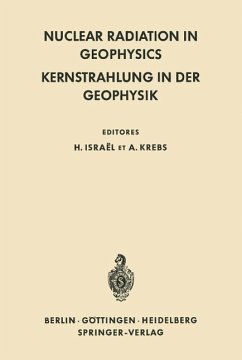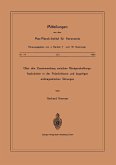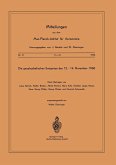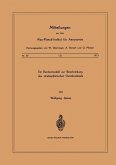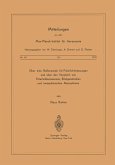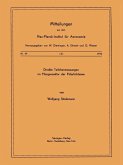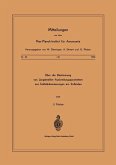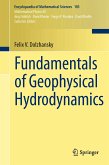Nuclear Radiation in Geophysics / Kernstrahlung in der Geophysik (eBook, PDF)
Redaktion: Israel, Hans; Krebs, Adolf
-22%11
42,99 €
54,99 €**
42,99 €
inkl. MwSt.
**Preis der gedruckten Ausgabe (Broschiertes Buch)
Sofort per Download lieferbar

21 °P sammeln
-22%11
42,99 €
54,99 €**
42,99 €
inkl. MwSt.
**Preis der gedruckten Ausgabe (Broschiertes Buch)
Sofort per Download lieferbar
Alle Infos zum eBook verschenken

21 °P sammeln
Als Download kaufen

54,99 €****
-22%11
42,99 €
inkl. MwSt.
**Preis der gedruckten Ausgabe (Broschiertes Buch)
Sofort per Download lieferbar

21 °P sammeln
Jetzt verschenken
Alle Infos zum eBook verschenken
54,99 €****
-22%11
42,99 €
inkl. MwSt.
**Preis der gedruckten Ausgabe (Broschiertes Buch)
Sofort per Download lieferbar
Alle Infos zum eBook verschenken

21 °P sammeln
Nuclear Radiation in Geophysics / Kernstrahlung in der Geophysik (eBook, PDF)
Redaktion: Israel, Hans; Krebs, Adolf
- Format: PDF
- Merkliste
- Auf die Merkliste
- Bewerten Bewerten
- Teilen
- Produkt teilen
- Produkterinnerung
- Produkterinnerung

Bitte loggen Sie sich zunächst in Ihr Kundenkonto ein oder registrieren Sie sich bei
bücher.de, um das eBook-Abo tolino select nutzen zu können.
Hier können Sie sich einloggen
Hier können Sie sich einloggen
Sie sind bereits eingeloggt. Klicken Sie auf 2. tolino select Abo, um fortzufahren.

Bitte loggen Sie sich zunächst in Ihr Kundenkonto ein oder registrieren Sie sich bei bücher.de, um das eBook-Abo tolino select nutzen zu können.
- Geräte: PC
- ohne Kopierschutz
- eBook Hilfe
- Größe: 32.08MB
Andere Kunden interessierten sich auch für
- -22%11
![Über den Zusammenhang Zwischen Röntgenstrahlungs-Ausbrüchen in der Polarlichtzone und Bayartigen Erdmagnetischen Störungen (eBook, PDF) Über den Zusammenhang Zwischen Röntgenstrahlungs-Ausbrüchen in der Polarlichtzone und Bayartigen Erdmagnetischen Störungen (eBook, PDF)]() G. KremserÜber den Zusammenhang Zwischen Röntgenstrahlungs-Ausbrüchen in der Polarlichtzone und Bayartigen Erdmagnetischen Störungen (eBook, PDF)42,99 €
G. KremserÜber den Zusammenhang Zwischen Röntgenstrahlungs-Ausbrüchen in der Polarlichtzone und Bayartigen Erdmagnetischen Störungen (eBook, PDF)42,99 € - -22%11
![Die Geophysikalischen Ereignisse des 12. bis 14. November 1960 (eBook, PDF) Die Geophysikalischen Ereignisse des 12. bis 14. November 1960 (eBook, PDF)]() Die Geophysikalischen Ereignisse des 12. bis 14. November 1960 (eBook, PDF)42,99 €
Die Geophysikalischen Ereignisse des 12. bis 14. November 1960 (eBook, PDF)42,99 € - -22%11
![Ein Rechenmodell zur Beschreibung des Stratosphärischen Ozonkreislaufs (eBook, PDF) Ein Rechenmodell zur Beschreibung des Stratosphärischen Ozonkreislaufs (eBook, PDF)]() W. JessenEin Rechenmodell zur Beschreibung des Stratosphärischen Ozonkreislaufs (eBook, PDF)42,99 €
W. JessenEin Rechenmodell zur Beschreibung des Stratosphärischen Ozonkreislaufs (eBook, PDF)42,99 € - -22%11
![Über eine Ballonsonde für Polarlichtmessungen und über den Vergleich von Polarlichtemissionen, Röntgenstrahlen und Ionosphärischen Absorptionen (eBook, PDF) Über eine Ballonsonde für Polarlichtmessungen und über den Vergleich von Polarlichtemissionen, Röntgenstrahlen und Ionosphärischen Absorptionen (eBook, PDF)]() K. RichterÜber eine Ballonsonde für Polarlichtmessungen und über den Vergleich von Polarlichtemissionen, Röntgenstrahlen und Ionosphärischen Absorptionen (eBook, PDF)42,99 €
K. RichterÜber eine Ballonsonde für Polarlichtmessungen und über den Vergleich von Polarlichtemissionen, Röntgenstrahlen und Ionosphärischen Absorptionen (eBook, PDF)42,99 € - -22%11
![Direkte Teilchenmessungen im Morgensektor der Polarlichtzone (eBook, PDF) Direkte Teilchenmessungen im Morgensektor der Polarlichtzone (eBook, PDF)]() W. StüdemannDirekte Teilchenmessungen im Morgensektor der Polarlichtzone (eBook, PDF)42,99 €
W. StüdemannDirekte Teilchenmessungen im Morgensektor der Polarlichtzone (eBook, PDF)42,99 € - -22%11
![Über die Bestimmung von Längstwellen-Ausbreitungsparametern aus Feldstärkemessungen am Erdboden (eBook, PDF) Über die Bestimmung von Längstwellen-Ausbreitungsparametern aus Feldstärkemessungen am Erdboden (eBook, PDF)]() J. FrisiusÜber die Bestimmung von Längstwellen-Ausbreitungsparametern aus Feldstärkemessungen am Erdboden (eBook, PDF)42,99 €
J. FrisiusÜber die Bestimmung von Längstwellen-Ausbreitungsparametern aus Feldstärkemessungen am Erdboden (eBook, PDF)42,99 € ![Fundamentals of Geophysical Hydrodynamics (eBook, PDF) Fundamentals of Geophysical Hydrodynamics (eBook, PDF)]() Felix V. DolzhanskyFundamentals of Geophysical Hydrodynamics (eBook, PDF)73,95 €
Felix V. DolzhanskyFundamentals of Geophysical Hydrodynamics (eBook, PDF)73,95 €- -21%11
-
-
Produktdetails
- Verlag: Springer Berlin Heidelberg
- Seitenzahl: 460
- Erscheinungstermin: 8. März 2013
- Deutsch
- ISBN-13: 9783642928376
- Artikelnr.: 53381284
Dieser Download kann aus rechtlichen Gründen nur mit Rechnungsadresse in A, B, BG, CY, CZ, D, DK, EW, E, FIN, F, GR, HR, H, IRL, I, LT, L, LR, M, NL, PL, P, R, S, SLO, SK ausgeliefert werden.
- Herstellerkennzeichnung Die Herstellerinformationen sind derzeit nicht verfügbar.
Radioactivity of the Lithosphere.- The Rice Institute, Houston Texas (USA). (With 1 Figure).- Zusammenfassung.- A. General considerations.- I. Sampling.- II. Analytical methods.- B. Abundances of natural radioactive nuclei.- I. Types of natural radioactive nuclei.- II. Direct abundance data.- III. Theoretical considerations.- C. Heat effects.- D. Distribution of radioactive elements.- I. Distribution on a global scale.- II. Microdistribution of radioactivity.- E. Radiation damage.- F. Fossil record.- G. Effects on stable isotope abundances.- H. The rock or geochemical cycle.- Selected bibliography.- Radioactivity in Oceanography.- University of Miami. The Marine Laboratory, Miami, Florida (USA). (With 1 Figure).- Zusammenfassung.- A. Introduction.- B. Occurrence of radioactive elements in the oceanic envelope.- I. Primordial radioactive isotopes.- 1. Uranium.- 2. Protactinium.- 3. Thorium.- 4. Radium.- 5. Short-lived daughter products.- 6. Stable lead isotopes.- 7. Rhenium-187.- 8. Rare earths and other heavy elements.- 9. Rubidium-87.- 10. Potassium-40.- II. Cosmic-ray produced radioactive isotopes.- 1. Short half-lived isotopes.- 2. Silicon-32.- 3. Carbon-14.- 4. Beryllium.- 5. Hydrogen-3.- III. Artificial radioactivity.- 1. Strontium-90, cerium-144, promethium-147, and cesium-137.- 2. Chlorine-36.- C. Applications of radioactivity data to oceanographic studies.- I. Atmosphere-ocean interface.- II. Continent-ocean interface.- III. Ocean phase.- IV. Ocean-sediment interface.- D. Future application of radioactivity in oceanography.- References.- Radioactivity in Hydrology.- International Meteorological Institute, University of Stockholm (Schweden). (With 2 Figures).- Zusammenfassung.- A. Natural radioactivity of waters.- I. Radioactivity from the uranium and thorium series in rocks.- II. Tritium.- III. Carbon-14.- IV. Other cosmic ray produced radioactive isotopes.- B. Artificially produced radioactive isotopes.- I. Bomb produced.- II. Commercially available radioactive isotopes applied to water for tracing purpose.- C. Water bodies as reservoirs and their characteristics as revealed by radioactive tracer studies.- I. General.- II. Stationary addition of a radioactive tracer.- III. Transient additions.- D. Other applications of radioactive tracers to hydrological problems.- I. Groundwater studies.- II. Mixing problems in lakes and rivers, determinations of stream flow and bed load transports.- III. Miscellaneous applications.- E. Conclusions.- F. Suggestions on future research.- References.- Radioactive Methods of Age Determination.- Jersey Production Research Company, Geological Division, Tulsa, Oklahoma (USA). (With 1 Figure).- Zusammenfassung.- A. Introduction.- B. The carbon-14 chronometer.- C. Potassium-40, argon-40 dating.- D. Rb-Sr dating.- E. Uranium lead method of age determination.- F. Conclusion.- References.- Die natürliche und künstliche Radioaktivität der Atmosphäre.- Rheinisch-Westfälische Technische Hochschule Aachen (Deutschland). (Mit 7 Figuren).- Summary.- A. Natürliche Radioaktivität.- I. Übersicht.- II. Der atmosphärische radioaktive Kreislauf.- III. Abschätzungen und Bilanz.- B. Künstliche Radioaktivität.- I. Übersicht.- II. Die Spaltprodukte.- III. Zeitliche Variationen.- Literatur.- Erzeugung radioaktiver Kernarten durch die kosmische Strahlung.- Physikalisches Institut der Universität Heidelberg (Deutschland). (Mit 10 Figuren).- Summary.- A. Entstehungs-Prozesse.- I. Kosmische Strahlung in der Atmosphäre.- II. Nukleonen-Kaskade, Neutronen-Einfang und Spallation.- III. Einfluß der Höhe und dergeomagnetischen Breite.- IV. Zeitliche Konstanz der Intensität der kosmischen Strahlung.- B. Der radioaktive Kohlenstoff C14.- I. Natürliche Erzeugung.- II. C14-Reservoir.- III. Industrie-Effekt.- IV. C14 aus Kernwaffen-Explosionen.- C. Beryllium.- I. Wirkungsquerschnitte und Erzeugungsraten.- II. Be7 in der Atmosphäre.- III. Beryllium-10.- D. Argon-Spallationsprodukte.- I. Erzeugung.- II. Meßergebnisse.- E. Tritium.- I. Natürliche Erzeugung.- II. Tritium im atmosphärischen Wasserstoff.- III. Tritium in HTO.- IV. Tritium-Bilanz.- F. Radioaktivität in Gesteinen und Meteoriten.- I. Terrestrische Gesteine und Tektite.- II. Meteorite.- III. Strahlungsalter.- Literatur.- Transfer and Circulation of Radioactivity in the Atmosphere.- International Meteorological Institute, University of Stockholm (Schweden). (With 16 Figures).- Zusammenfassung.- A. Introduction.- B. Theory of diffusion.- C. Diffusion and transfer of radioactivity in the surface layers of the atmosphere.- I. Diffusion from point sources.- II. Diffusion from a distributed source at the surface of the earth.- D. Small- and intermediate-scale diffusion and circulation of radioactivity in the free atmosphere.- E. Global transfer and circulation of radioactivity in the atmosphere.- I. The general circulation of the atmosphere.- II. Daughter products of radon in the upper troposphere and stratosphere.- III. Radioactivity formed by cosmic radiation in the atmosphere.- IV. The global circulation of the atmosphere as deduced from the distribution and fall-out of artificial radioactivity.- V. Final remarks.- References.- Radioaktive Aerosole.- Meteorologisches Institut der Universität Mainz (Deutschland). (Mit 5 Figuren).- Summary.- A. Die Radioaktivität der Radon- und Thoronzerfallprodukte und ihre Anlagerungan troposphärische Aerosole.- I. Die troposphärischen Aerosole.- II. Die Anlagerung der Radon- und Thoronzerfallsprodukte an die troposphärischen Aerosole.- B. Die durch kosmische Strahlung erzeugten Radioaktivitäten und ihre Anlagerung an stratosphärische Aerosole.- C. Die Aerosole der künstlichen Radioaktivitäten.- I. Die Teilchen im Nahausfall von Atomversuchen.- II. Die Teilchen des mittelfristigen Ausfalls.- III. Teilchen des langfristigen Ausfalls.- IV. Radioaktivitäten von Reaktoren.- Schlußfolgerungen.- Literatur.- Radioactive Precipitations and Fallout.- Office Nationale Météorologique, Paris (Frankreich). (With 23 Figures).- Zusammenfassung.- A. Introduction.- I. Definition.- II. Dry weather deposition.- III. Wet deposition due to atmosphérique moisture.- B. Dynamics of small particles in dry weather conditions.- I. Velocity of fall or "settling velocity" of a small particle.- 1. Expression of the drag resistance.- 2. The terminal velocity.- a) The Cunningham's correction.- b) The shape factor.- 3. Settling of particles under gravity.- a) Tranquil settling.- b) Stirred settling.- II. Diffusion processes and non-gravitational forces.- 1. Brownian movement.- 2. Diffusion coefficient.- 3. Coagulation of particles.- 4. Thermal diffusion and photophoresis.- 5. Electrostatic and sound vibration actions.- 6. Turbulence as coagulation process.- III. Scavenging due to particle inertia.- C. Wash out processes or wet removal of radioactive particles.- I. Scavenging due to coagulation particle droplet.- II. Scavenging due to condensation processes on cloud droplets.- III. The rain-out of radioactive particles.- IV. Peculiarity of the snow-out processes.- V. Total radioactive balance of wet removal processes.- 1. The specific activity of cloud droplets.-2. Relation between specific activity and the amount of rain fall.- 3. The total specific activity of precipitations.- D. General considerations on the turbulent mixing.- E. The direct ground capture of air activity.- I. Coagulation with soil particles and foliar uptake.- II. Water vapour and ground captures.- 1. Dew and rime formation.- 2. Capillary condensation on dry surfaces.- F. Near future researchs in the fall out field.- General bibliography.- Annoted bibliography.- Biological Aspects.- Biology Department, University of Louisville, Kentucky (USA) and Dr. N. G. STEWART, Head of Health Physics and Medical Division, Atomic Energy Research Establishment, Harwell, Berks. (Great Britain). (With 14 Figures).- Zusammenfassung.- A. Introduction.- B. Nature-given radiations.- I. External radiation sources.- 1. Natural background radiations.- 2. Cosmic radiation.- II. Internal radiation sources.- C. Biological evaluation of the nature-given radiation doses.- I. General principles.- II. Specific effects.- 1. Somatic effects.- 2. Genetic effects.- D. Manmade environmental contamination.- I. Dust from nuclear explosions.- 1. Internal and external sources of radiation.- 2. Movement and deposition of dust from nuclear explosions.- 3. Inhalation and ingestion of fission products from nuclear explosions.- a) Strontium-90.- b) Cesium-137.- c) Iodine-131.- d) Carbon-14.- 4. External radiation from fission products.- 5. Total doses to tissue from nuclear explosions.- II. The disposal of radioactive wastes.- 1. High activity wastes.- 2. Low and medium activity wastes.- 3. Gaseous effluent.- 4. Genetic dose due to effluent discharges.- III. Environmental hazards from accidents to reactors or other nuclear plants.- 1. Accidental release of radioactivity into the atmosphere. The Windscale accident.- 2. Maximum permissible doses to the public in an emergency.- 3. Reactor siting.- Recommendations.- References.- Meßmethoden.- Physikalisches Institut der Universität Heidelberg (Deutschland). (Mit 9 Figuren).- Summary.- I. Allgemeine Grundsätze für Messung niedriger Aktivitäten.- 1. Statistik.- 2. Ansprechwahrscheinlichkeit.- 3. Nulleffekt-Reduktion.- 4. Elektronik.- 5. Dicke Präparate.- 6. Eichung.- II. Anwendung auf verschiedene Detektoren.- 1. Ionisationskammer.- 2. Geiger-Zähler.- 3. Proportionalzähler.- 4. Szintillationszähler.- 5. Photographische Methoden.- III. Radiochemische Methoden.- 1. Verhalten unwägbarer Substanzmengen.- 2. Arbeitsmethoden.- 3. Spezielle Nuklide.- IV. Probenahme.- 1. Allgemeine Gesichtspunkte.- 2. Gasproben.- 3. Aerosolproben.- 4. Niederschlag und Wasser.- 5. Mineral- und Bodenproben.- V. Messungen an Gasen.- 1. Edelgase.- 2. C14 und H3.- VI. Messungen an Aerosolen und Wasserproben.- 1. Arbeiten mit Aerosolproben.- 2. Messungen an Flüssigkeiten.- 3. Anreicherung von Flüssigkeitsproben.- 4. Analyse des Abfalls.- 5. Energiediskriminierung.- VII. Messungen an Mineral- und Bodenproben.- 1. Messungen von Totalaktivitäten.- 2. a- und y-Spektroskopie.- 3. Messungen mit Photoemulsionen.- 4. Fluorimetrie.- Literatur.- Die Kosmische Strahlung in der Geophysik.- Max-Planck- Institut für Aeronomie, Lindau, Han. (Deutschland). (Mit 23 Figuren).- A. Einleitung.- B. Die primäre galaktische Kosmische Strahlung.- C. Der Einfluß des Magnetfeldes der Erde auf die galaktische Kosmische Strahlung..- I. Die Bewegung der Teilchen.- II. Der Breiteneffekt.- III. Der Längeneffekt.- IV. Die Verteilung über die Erde, die Isokosmen.- D. Die Sekundärstrahlung.- E. Die Meßmethoden.- F. Die Komponenten der galaktischen Strahlung und ihreSekundärstrahlung in der Atmosphäre.- G. Die Modulation der galaktischen Strahlung durch die Sonnentätigkeit.- H. Isotrope und anisotrope Modulation.- J. Modulation der Kosmischen Strahlung und erdmagnetischem Feld.- K. Die solare Kosmische Strahlung.- I. Beobachtungen.- II. Bewegung der solaren Kosmischen Strahlung im Erdfeld.- III. Solare Kosmische Strahlung geringer Energie.- IV. Die Ausbreitung solarer Kosmischer Strahlung.- L. Schlußbetrachtung.- Summary.- Literatur.- Anhang (Tabellen).- Namenverzeichnis.- Sachverzeichnis (Deutsch-Englisch).- Subject Index (English-German).
Radioactivity of the Lithosphere.- The Rice Institute, Houston Texas (USA). (With 1 Figure).- Zusammenfassung.- A. General considerations.- I. Sampling.- II. Analytical methods.- B. Abundances of natural radioactive nuclei.- I. Types of natural radioactive nuclei.- II. Direct abundance data.- III. Theoretical considerations.- C. Heat effects.- D. Distribution of radioactive elements.- I. Distribution on a global scale.- II. Microdistribution of radioactivity.- E. Radiation damage.- F. Fossil record.- G. Effects on stable isotope abundances.- H. The rock or geochemical cycle.- Selected bibliography.- Radioactivity in Oceanography.- University of Miami. The Marine Laboratory, Miami, Florida (USA). (With 1 Figure).- Zusammenfassung.- A. Introduction.- B. Occurrence of radioactive elements in the oceanic envelope.- I. Primordial radioactive isotopes.- 1. Uranium.- 2. Protactinium.- 3. Thorium.- 4. Radium.- 5. Short-lived daughter products.- 6. Stable lead isotopes.- 7. Rhenium-187.- 8. Rare earths and other heavy elements.- 9. Rubidium-87.- 10. Potassium-40.- II. Cosmic-ray produced radioactive isotopes.- 1. Short half-lived isotopes.- 2. Silicon-32.- 3. Carbon-14.- 4. Beryllium.- 5. Hydrogen-3.- III. Artificial radioactivity.- 1. Strontium-90, cerium-144, promethium-147, and cesium-137.- 2. Chlorine-36.- C. Applications of radioactivity data to oceanographic studies.- I. Atmosphere-ocean interface.- II. Continent-ocean interface.- III. Ocean phase.- IV. Ocean-sediment interface.- D. Future application of radioactivity in oceanography.- References.- Radioactivity in Hydrology.- International Meteorological Institute, University of Stockholm (Schweden). (With 2 Figures).- Zusammenfassung.- A. Natural radioactivity of waters.- I. Radioactivity from the uranium and thorium series in rocks.- II. Tritium.- III. Carbon-14.- IV. Other cosmic ray produced radioactive isotopes.- B. Artificially produced radioactive isotopes.- I. Bomb produced.- II. Commercially available radioactive isotopes applied to water for tracing purpose.- C. Water bodies as reservoirs and their characteristics as revealed by radioactive tracer studies.- I. General.- II. Stationary addition of a radioactive tracer.- III. Transient additions.- D. Other applications of radioactive tracers to hydrological problems.- I. Groundwater studies.- II. Mixing problems in lakes and rivers, determinations of stream flow and bed load transports.- III. Miscellaneous applications.- E. Conclusions.- F. Suggestions on future research.- References.- Radioactive Methods of Age Determination.- Jersey Production Research Company, Geological Division, Tulsa, Oklahoma (USA). (With 1 Figure).- Zusammenfassung.- A. Introduction.- B. The carbon-14 chronometer.- C. Potassium-40, argon-40 dating.- D. Rb-Sr dating.- E. Uranium lead method of age determination.- F. Conclusion.- References.- Die natürliche und künstliche Radioaktivität der Atmosphäre.- Rheinisch-Westfälische Technische Hochschule Aachen (Deutschland). (Mit 7 Figuren).- Summary.- A. Natürliche Radioaktivität.- I. Übersicht.- II. Der atmosphärische radioaktive Kreislauf.- III. Abschätzungen und Bilanz.- B. Künstliche Radioaktivität.- I. Übersicht.- II. Die Spaltprodukte.- III. Zeitliche Variationen.- Literatur.- Erzeugung radioaktiver Kernarten durch die kosmische Strahlung.- Physikalisches Institut der Universität Heidelberg (Deutschland). (Mit 10 Figuren).- Summary.- A. Entstehungs-Prozesse.- I. Kosmische Strahlung in der Atmosphäre.- II. Nukleonen-Kaskade, Neutronen-Einfang und Spallation.- III. Einfluß der Höhe und dergeomagnetischen Breite.- IV. Zeitliche Konstanz der Intensität der kosmischen Strahlung.- B. Der radioaktive Kohlenstoff C14.- I. Natürliche Erzeugung.- II. C14-Reservoir.- III. Industrie-Effekt.- IV. C14 aus Kernwaffen-Explosionen.- C. Beryllium.- I. Wirkungsquerschnitte und Erzeugungsraten.- II. Be7 in der Atmosphäre.- III. Beryllium-10.- D. Argon-Spallationsprodukte.- I. Erzeugung.- II. Meßergebnisse.- E. Tritium.- I. Natürliche Erzeugung.- II. Tritium im atmosphärischen Wasserstoff.- III. Tritium in HTO.- IV. Tritium-Bilanz.- F. Radioaktivität in Gesteinen und Meteoriten.- I. Terrestrische Gesteine und Tektite.- II. Meteorite.- III. Strahlungsalter.- Literatur.- Transfer and Circulation of Radioactivity in the Atmosphere.- International Meteorological Institute, University of Stockholm (Schweden). (With 16 Figures).- Zusammenfassung.- A. Introduction.- B. Theory of diffusion.- C. Diffusion and transfer of radioactivity in the surface layers of the atmosphere.- I. Diffusion from point sources.- II. Diffusion from a distributed source at the surface of the earth.- D. Small- and intermediate-scale diffusion and circulation of radioactivity in the free atmosphere.- E. Global transfer and circulation of radioactivity in the atmosphere.- I. The general circulation of the atmosphere.- II. Daughter products of radon in the upper troposphere and stratosphere.- III. Radioactivity formed by cosmic radiation in the atmosphere.- IV. The global circulation of the atmosphere as deduced from the distribution and fall-out of artificial radioactivity.- V. Final remarks.- References.- Radioaktive Aerosole.- Meteorologisches Institut der Universität Mainz (Deutschland). (Mit 5 Figuren).- Summary.- A. Die Radioaktivität der Radon- und Thoronzerfallprodukte und ihre Anlagerungan troposphärische Aerosole.- I. Die troposphärischen Aerosole.- II. Die Anlagerung der Radon- und Thoronzerfallsprodukte an die troposphärischen Aerosole.- B. Die durch kosmische Strahlung erzeugten Radioaktivitäten und ihre Anlagerung an stratosphärische Aerosole.- C. Die Aerosole der künstlichen Radioaktivitäten.- I. Die Teilchen im Nahausfall von Atomversuchen.- II. Die Teilchen des mittelfristigen Ausfalls.- III. Teilchen des langfristigen Ausfalls.- IV. Radioaktivitäten von Reaktoren.- Schlußfolgerungen.- Literatur.- Radioactive Precipitations and Fallout.- Office Nationale Météorologique, Paris (Frankreich). (With 23 Figures).- Zusammenfassung.- A. Introduction.- I. Definition.- II. Dry weather deposition.- III. Wet deposition due to atmosphérique moisture.- B. Dynamics of small particles in dry weather conditions.- I. Velocity of fall or "settling velocity" of a small particle.- 1. Expression of the drag resistance.- 2. The terminal velocity.- a) The Cunningham's correction.- b) The shape factor.- 3. Settling of particles under gravity.- a) Tranquil settling.- b) Stirred settling.- II. Diffusion processes and non-gravitational forces.- 1. Brownian movement.- 2. Diffusion coefficient.- 3. Coagulation of particles.- 4. Thermal diffusion and photophoresis.- 5. Electrostatic and sound vibration actions.- 6. Turbulence as coagulation process.- III. Scavenging due to particle inertia.- C. Wash out processes or wet removal of radioactive particles.- I. Scavenging due to coagulation particle droplet.- II. Scavenging due to condensation processes on cloud droplets.- III. The rain-out of radioactive particles.- IV. Peculiarity of the snow-out processes.- V. Total radioactive balance of wet removal processes.- 1. The specific activity of cloud droplets.-2. Relation between specific activity and the amount of rain fall.- 3. The total specific activity of precipitations.- D. General considerations on the turbulent mixing.- E. The direct ground capture of air activity.- I. Coagulation with soil particles and foliar uptake.- II. Water vapour and ground captures.- 1. Dew and rime formation.- 2. Capillary condensation on dry surfaces.- F. Near future researchs in the fall out field.- General bibliography.- Annoted bibliography.- Biological Aspects.- Biology Department, University of Louisville, Kentucky (USA) and Dr. N. G. STEWART, Head of Health Physics and Medical Division, Atomic Energy Research Establishment, Harwell, Berks. (Great Britain). (With 14 Figures).- Zusammenfassung.- A. Introduction.- B. Nature-given radiations.- I. External radiation sources.- 1. Natural background radiations.- 2. Cosmic radiation.- II. Internal radiation sources.- C. Biological evaluation of the nature-given radiation doses.- I. General principles.- II. Specific effects.- 1. Somatic effects.- 2. Genetic effects.- D. Manmade environmental contamination.- I. Dust from nuclear explosions.- 1. Internal and external sources of radiation.- 2. Movement and deposition of dust from nuclear explosions.- 3. Inhalation and ingestion of fission products from nuclear explosions.- a) Strontium-90.- b) Cesium-137.- c) Iodine-131.- d) Carbon-14.- 4. External radiation from fission products.- 5. Total doses to tissue from nuclear explosions.- II. The disposal of radioactive wastes.- 1. High activity wastes.- 2. Low and medium activity wastes.- 3. Gaseous effluent.- 4. Genetic dose due to effluent discharges.- III. Environmental hazards from accidents to reactors or other nuclear plants.- 1. Accidental release of radioactivity into the atmosphere. The Windscale accident.- 2. Maximum permissible doses to the public in an emergency.- 3. Reactor siting.- Recommendations.- References.- Meßmethoden.- Physikalisches Institut der Universität Heidelberg (Deutschland). (Mit 9 Figuren).- Summary.- I. Allgemeine Grundsätze für Messung niedriger Aktivitäten.- 1. Statistik.- 2. Ansprechwahrscheinlichkeit.- 3. Nulleffekt-Reduktion.- 4. Elektronik.- 5. Dicke Präparate.- 6. Eichung.- II. Anwendung auf verschiedene Detektoren.- 1. Ionisationskammer.- 2. Geiger-Zähler.- 3. Proportionalzähler.- 4. Szintillationszähler.- 5. Photographische Methoden.- III. Radiochemische Methoden.- 1. Verhalten unwägbarer Substanzmengen.- 2. Arbeitsmethoden.- 3. Spezielle Nuklide.- IV. Probenahme.- 1. Allgemeine Gesichtspunkte.- 2. Gasproben.- 3. Aerosolproben.- 4. Niederschlag und Wasser.- 5. Mineral- und Bodenproben.- V. Messungen an Gasen.- 1. Edelgase.- 2. C14 und H3.- VI. Messungen an Aerosolen und Wasserproben.- 1. Arbeiten mit Aerosolproben.- 2. Messungen an Flüssigkeiten.- 3. Anreicherung von Flüssigkeitsproben.- 4. Analyse des Abfalls.- 5. Energiediskriminierung.- VII. Messungen an Mineral- und Bodenproben.- 1. Messungen von Totalaktivitäten.- 2. a- und y-Spektroskopie.- 3. Messungen mit Photoemulsionen.- 4. Fluorimetrie.- Literatur.- Die Kosmische Strahlung in der Geophysik.- Max-Planck- Institut für Aeronomie, Lindau, Han. (Deutschland). (Mit 23 Figuren).- A. Einleitung.- B. Die primäre galaktische Kosmische Strahlung.- C. Der Einfluß des Magnetfeldes der Erde auf die galaktische Kosmische Strahlung..- I. Die Bewegung der Teilchen.- II. Der Breiteneffekt.- III. Der Längeneffekt.- IV. Die Verteilung über die Erde, die Isokosmen.- D. Die Sekundärstrahlung.- E. Die Meßmethoden.- F. Die Komponenten der galaktischen Strahlung und ihreSekundärstrahlung in der Atmosphäre.- G. Die Modulation der galaktischen Strahlung durch die Sonnentätigkeit.- H. Isotrope und anisotrope Modulation.- J. Modulation der Kosmischen Strahlung und erdmagnetischem Feld.- K. Die solare Kosmische Strahlung.- I. Beobachtungen.- II. Bewegung der solaren Kosmischen Strahlung im Erdfeld.- III. Solare Kosmische Strahlung geringer Energie.- IV. Die Ausbreitung solarer Kosmischer Strahlung.- L. Schlußbetrachtung.- Summary.- Literatur.- Anhang (Tabellen).- Namenverzeichnis.- Sachverzeichnis (Deutsch-Englisch).- Subject Index (English-German).
